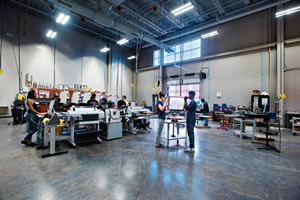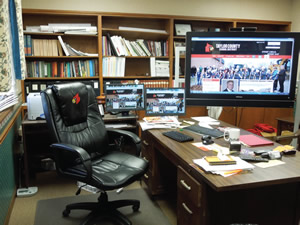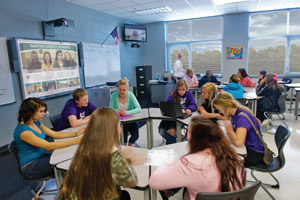Technology and Collaboration, Chicken or Egg?

PHOTO COURTESY OF COURTESY OF BOOMERANG DESIGN/FISHEYE STUDIOS, INC.
Glenn Meeks’ message in his book “Creating a Culture of Learning” is straightforward. Decide what needs to occur in your educational environment, and then select the appropriate technology and support systems to make it happen. Clearly, this is also the case in the development of collaborative learning spaces. While technology does not create collaboration, its presence and use in the learning environment is foundational for groups of people working together effectively. Victoria Bergsagel, president of Architects of Achievement, an organization that bridges the gap between educational practice and architecture says, “Students today prefer active learning, in welcoming spaces, with people who take an interest in them and their curiosities. Technology, when used appropriately, can significantly enhance such collaboration.”
When we construct new spaces for students to learn and work with others, they tend to have several similarities: multi-use surfaces for projection of images or writing/posting progress notes, lightweight moveable furniture with multiple work surfaces, small mobile teaching stations, audiovisual capacity, wired and/or wireless connectivity, shared devices that permit students and teachers to access each other’s work, and plenty of space to move around. However, learning spaces tend to adapt to local conditions and budgets. Since the majority of our facility infrastructure is already built, today’s collaborative learning occurs most often in existing classrooms with very few of these 21st century learning amenities with one exception — technology.

PHOTO COURTESY OF TAYLOR COUNTY SCHOOLS
High-tech superintendents. The superintendent’s office of Taylor County Schools, in Campbellsville, Ky., is just one example of how things have changed in school administration due to the advances of technology. There are several monitors, and an interactive whiteboard with a back facing camera so he can interact with the staff throughout the day. In fact, he used this technology to institute “cyber snow days” to avoid the loss of instructional days last winter.
Unlike the traditional “teacher centered” classroom of the past, effective use of technology requires flexibility of space. The best examples of newly developed collaborative learning spaces include furniture that can be easily rearranged which is adaptable to student preferences regarding working heights and movement. The space accommodates visual displays that are easily moved around the room depending upon student groupings. Working groups within the learning environment are acoustically isolated and lighting levels are adjusted to maintain visual clarity of the digital displays.
Space for academic collaboration must be enlarged to accommodate multiple types of learning. Teamwork may involve small group discussion, project-based learning, cross-content instruction, and independent study. The learning space must accommodate all of these learning platforms and an individual student’s learning style. Additionally, students absent from school may participate in class through video feeds and software that allows the teacher to not only see the work of the students in the classroom, but also the work of students that are participating remotely. This is where technology plays a feature role by sharing results and observations as well as work on team projects. Technology has given us the chance to share and come together with or without a physical presence, which makes all the difference. Students are no longer limited by their own experiences or their own observations in class and can work simultaneously with classmates in the same room or halfway around the world.
Collaborative learning cannot always occur in the ideal environment. Like much that occurs in today’s education, adaptation to current conditions is necessary. Connectivity is essential. A classroom of 25 students with two or three devices (laptop, tablet, phone) needs enough wireless access points to simultaneously accommodate those devices without a loss of speed or computing capacity because they are all up and running at one time. Access points and bandwidth have become the latest educational infrastructure challenge.
Unfortunately the solution is not one size fits all, but requires adaptation to local conditions, preferences, and budgets. External capacity is also an issue to consider as well. Many school systems are now allowing students and staff to use their smartphones during the school day. This increases the load on the local cell service infrastructure. The tower capacity to support a 2000 student high school is significant.

PHOTO COURTESY OF BOOMERANG DESIGN/FISHEYE STUDIOS, INC.
Not like it used to be. Classrooms in the Stuart W. Cramer High School, in Gaston County, N.C., are no longer like the traditional “teacher centered” classroom of the past. Ito accommodate the effective use of technology, the classrooms have flexible space. Creating that involves the inclusion of furniture that can be easily rearranged which is adaptable to student preferences regarding working heights and movement. The spaces need to accommodate visual displays that can be easily moved around the room depending upon student groupings. Working groups within the learning environment need to be acoustically isolated, and lighting levels must be adjustable to maintain visual clarity of the digital displays.
Since professional staff working together to solve issues of instructional delivery also has benefits, many districts have created professional learning communities (PLCs) for professional collaboration. Some PLCs have been formed around content areas while others may be arranged around grade levels. For example, teachers may work together in PLCs to improve their instructional techniques and to compare notes about what has been successful or not with struggling students. While this could certainly occur without the use of technology, it is the real time student data and the accompanying trending reports available electronically that make these discussions factual and less subjective.
Although teacher planning has moved into the 21st century with the creation of PLCs, the planning spaces themselves have not changed much since the 1970s. Professional learning communities often use an empty classroom or conference room. Perhaps we can take a lesson in creating collaborative learning spaces from corporations that are considered innovative in today’s marketplace like Apple and Google. Rather than creating spaces specifically for collaborative work, they direct their attention to common areas (cafeteria, hallways, lobbies, stairs) and focus on making them inviting and stimulating. When we have the opportunity to create space for faculty collaboration, perhaps we should also think about enhancing common areas for the same purpose.
Of course, district leaders must develop collaborative relationships as well. Not so long ago the desktop computer in the superintendent’s office was used as a paperweight or a symbol to indicate that the district was up to date with technology. This is certainly not the case any longer. Today’s superintendents and district leaders would be lost without access to e-mails on their smartphones and tablets. Roger Cook, superintendent of Taylor County Schools in Campbellsville, Ky., uses his interactive whiteboard and its integral back facing camera as a way to collaborate with his entire staff during early release Fridays or with his parents on issues such as changes in traffic patterns at the high school or progress reports on new construction. During last year’s record snowfall in Kentucky, he used this technology to announce the utilization of “cyber snow days,” avoiding additional lost instructional days. Participation on the snow day was actually better than attendance on a typical school day.
Access to technology has created a certain synergy that seems to promote and enhance collaboration among education professionals and their students. Of course, it’s not just additional classroom space and interconnected student devices that are required, but also digital connections to the faculty and appropriate software to provide access to their expertise and to the academic content. Superintendents, administrators, teachers, students and the community will undoubtedly continue to work together at various levels. Increasingly, technology will not only facilitate that collaboration, but also reinforce its importance.
This article originally appeared in the issue of .